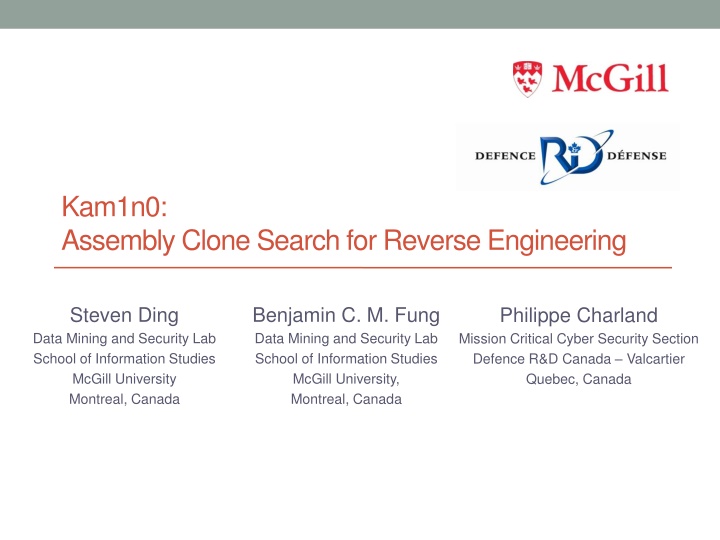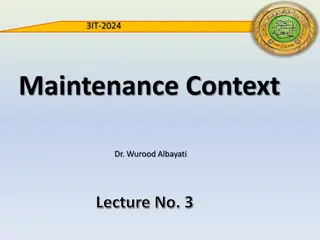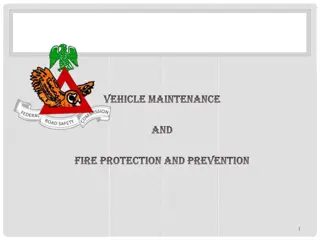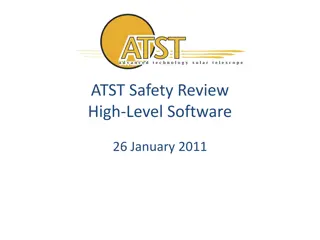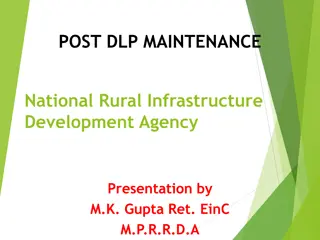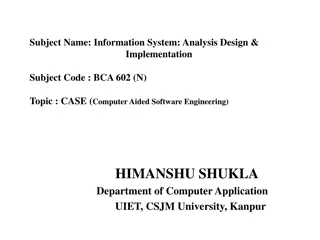Program Comprehension During Software Maintenance
This summary discusses various program comprehension models in the context of software maintenance and evolution. It explores the importance of understanding code, identifies key cognitive processes in maintenance tasks, and analyzes existing models in the field. The content delves into the significance of programmers' mental models and raises questions surrounding the scalability and validity of experimental results in large-scale code scenarios.
Download Presentation

Please find below an Image/Link to download the presentation.
The content on the website is provided AS IS for your information and personal use only. It may not be sold, licensed, or shared on other websites without obtaining consent from the author.If you encounter any issues during the download, it is possible that the publisher has removed the file from their server.
You are allowed to download the files provided on this website for personal or commercial use, subject to the condition that they are used lawfully. All files are the property of their respective owners.
The content on the website is provided AS IS for your information and personal use only. It may not be sold, licensed, or shared on other websites without obtaining consent from the author.
E N D
Presentation Transcript
Kam1n0: Assembly Clone Search for Reverse Engineering Steven Ding Data Mining and Security Lab School of Information Studies McGill University Montreal, Canada Benjamin C. M. Fung Data Mining and Security Lab School of Information Studies McGill University, Montreal, Canada Philippe Charland Mission Critical Cyber Security Section Defence R&D Canada Valcartier Quebec, Canada
2 Reverse Engineering 0xEB68 PUSH {R7,LR} 0xEB6A SUB SP, SP, #0x10 0xEB6C ADD R7, SP, #0 0xEB6E STR R0, [R7,#0x10+s] 0xEB70 STR R1, [R7,#0x10+buf] 0xEB72 STR R2, [R7,#0x10+len] 0xEB74 STR R3, [R7,#0x10+header] 0xEB76 LDR R0, [R7,#0x10+s] 0xEB78 BL bi_windup 0xEB7C LDR R3, [R7,#0x10+s] 0xEB7E ADD.W R3, R3, #0x16A0 0xEB82 ADDS R3, #0x14 0xEB84 MOVS R2, #8 0xEB86 STR R2, [R3] 0xEB88 LDR R3, [R7,#0x10+header] 0xEB8A CMP R3, #0 0xEB8C BEQ loc_EBFC 0xEB8E LDR R3, [R7,#0x10+s] 0xEB90 LDR R2, [R3,#8] 0xEB92 LDR R3, [R7,#0x10+s] 0xEB94 LDR R3, [R3,#0x14] 0xEB96 ADDS R0, R3, #1 0xEB98 LDR R1, [R7,#0x10+s] 0xEB9A STR R0, [R1,#0x14] 0xEB9C ADD R3, R2 0xEB9E LDR R2, [R7,#0x10+len] 0xEBA0 UXTB R2, R2 0xEBA2 STRB R2, [R3] 0xEBA4 LDR R3, [R7,#0x10+s] 0xEBA6 LDR R2, [R3,#8] 0xEBA8 LDR R3, [R7,#0x10+s] 0xEBAA LDR R3, [R3,#0x14] 0xEBAC ADDS R0, R3, #1 0xEBAE LDR R1, [R7,#0x10+s] 0xEBB0 STR R0, [R1,#0x14] 0xEBB2 ADD R3, R2 0xEBB4 LDR R2, [R7,#0x10+len] 0xEBB6 UXTH R2, R2 0xEBB8 LSRS R2, R2, #8 0xEBBA UXTH R2, R2 0xEBBC UXTB R2, R2 0xEBBE STRB R2, [R3] 0xEBC0 LDR R3, [R7,#0x10+s] 0xEBC2 LDR R2, [R3,#8] 0xEBC4 LDR R3, [R7,#0x10+s] 0xEBC6 LDR R3, [R3,#0x14] 0xEBC8 ADDS R0, R3, #1 0xEBCA LDR R1, [R7,#0x10+s] 0xEBCC STR R0, [R1,#0x14] 0xEBCE ADD R3, R2 0xEBD0 LDR R2, [R7,#0x10+len] 0xEBD2 UXTB R2, R2 0xEBD4 MVNS R2, R2 0xEBD6 UXTB R2, R2 0xEBD8 STRB R2, [R3] 0xEBDA LDR R3, [R7,#0x10+s] 0xEBDC LDR R2, [R3,#8] 0xEBDE LDR R3, [R7,#0x10+s] 0xEBE0 LDR R3, [R3,#0x14] 0xEBE2 ADDS R0, R3, #1 0xEBE4 LDR R1, [R7,#0x10+s] 0xEBE6 STR R0, [R1,#0x14] 0xEBE8 ADD R3, R2 0xEBEA LDR R2, [R7,#0x10+len] 0xEBEC UXTH R2, R2 0xEBEE MVNS R2, R2 0xEBF0 UXTH R2, R2 0xEBF2 LSRS R2, R2, #8 0xEBF4 UXTH R2, R2 0xEBF6 UXTB R2, R2 0xEBF8 STRB R2, [R3] 0xEBFA B loc_EC18 0xEBFC B loc_EC18 0xEBFE LDR R3, [R7,#0x10+s] 0xEC00 LDR R2, [R3,#8] 0xEC02 LDR R3, [R7,#0x10+s] 0xEC04 LDR R3, [R3,#0x14] 0xEC06 ADDS R0, R3, #1 0xEC08 LDR R1, [R7,#0x10+s] 0xEC0A STR R0, [R1,#0x14] 0xEC0C ADD R2, R3 0xEC0E LDR R3, [R7,#0x10+buf] 0xEC10 ADDS R1, R3, #1 0xEC12 STR R1, [R7,#0x10+buf] 0xEC14 LDRB R3, [R3] 0xEC16 STRB R3, [R2] 0xEC18 LDR R3, [R7,#0x10+len] 0xEC1A SUBS R2, R3, #1 0xEC1C STR R2, [R7,#0x10+len] 0xEC1E CMP R3, #0 0xEC20 BNE loc_EBFE 0xEC22 ADDS R7, #0x10 0xEC24 MOV SP, R7 0xEC26 POP {R7,PC} void copy_block(deflate_state * s, charf * buf, unsigned len, int header){ bi_windup(s); s->last_eob_len = 8; if (header) { put_short(s, (ush)len); put_short(s, (ush)~len); } }
3 Reverse Engineering Malware analysis understanding the inner workings of new malware exploring new vulnerabilities in existing systems Patent infringements and software plagiarism GNU violation Code reuse Software vulnerability uncontrollably shared between projects
4 Assembly Clone Detection Original problem proposed by DRDC A repository of commented assembly code Try to transfer comments on existing assembly code to the assembly code under study/analysis Abstract concept No concrete definition of what is a clone Type I: literally identical Type II: syntactically equivalent Type III: minor modifications
5 Narrow down the use scenario Reverse engineer Did anyone analyze something similar before? Is it some library function?
6 Assembly Code Search Comments Assembly Code Control Flow Graph
7 Subgraph Clones New binary Comments
8 Clone Types
11 Challenges Accuracy: false positive rate Efficiency and scalability: response time with terabytes of assembly code in repository Incremental update of the repository Interpretability and usability Flexibility: binary files with different CPU architectures, compilers, and optimization options
12 Finding Clones
13 Overall Solution Stack IDA-Pro Connector (Plugin) Web-based user interface and clone visualization Bootstrap JQuery D3js Dagre RESTful API web services Results in Json HTTP POST/GET Kam1n0 engine format Assembly code processing utilities LSH-based assembly code clone search MR-based subgraph search Distributed/Local Map-Reduce compatible execution framework (Memory and CPUs) Return results Submit jobs Apache Spark: Local mode or distributed mode Load/cache data Persists data Data Storage layer (hard drives) Graph-based data storage model Bucket-based data storage model No-SQL database Apache Cassandra
14 Distributed deployment Yarn Node Manager Spark Worker Node (Spark executor) The Kam1n0 Engine Node Yarn Resource Manager Cassandra Data Node The Kam1n0 Engine Node Yarn Node Manager Yarn Node Manager Spark Worker Node (Spark executor) Spark Application Master The Kam1n0 Engine Node Cassandra Data Node Yarn Node Manager Map-Reduce Jobs Cluster management Cassandra Data Node connections Spark Worker Node (Spark executor) Cassandra Data Node
15 Efficiency (k-NN problem)
16 Efficiency (k-NN problem) Bin-Clone: Inefficient and not scalable Two combination of feature elements. Less accurate
17 Efficiency (k-NN problem) Locality Sensitive Hashing Equal partitioning and static hashing
Efficiency (k-NN problem) Adaptive Locality Sensitive Hashing Unequal partitioning and dynamic hashing for cosine space 18
19 Scalability (subgraph search) Mapper Reducer A block-to-block clone pair A cloned subgraph Cloned subgraphs of a function
21 Ground-truth dataset generation CCfinderX 0.9 0.9
23 Evaluation (quality) Area Under the Receiver Operating Characteristic Curve (AUROC)
24 Evaluation (quality) Area Under the Precision-Recall Curve (AUPR)
25 Evaluation (quality) Mean Average Precision at Position 10 (MAP@10)
26 Evaluation (scalability and efficiency) ~20ms to index a function ~1s to find the clones of a function
27 Summary: Kam1n0 Features High accuracy Efficient and scalable Handle multiple CPU architectures Visualizable results It s free with no catch! Future work Malware Clone search on binaries of different CPU architectures
Thank you. Questions? Recruitment: PhD students in data mining and security Benjamin Fung McGill Data Mining and Security Lab http://dmas.lab.mcgill.ca/fung E-mail: ben.fung (at) mcgill.ca
